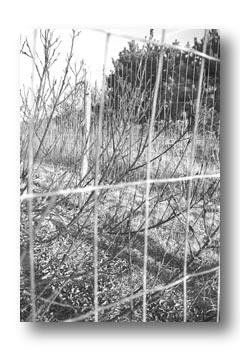Star Gardener

Today it's almost inevitable that when a group of gardeners gets together the conversation will turn, at one point or another, to deer and how to keep them out of the garden. Quail Hill, the cooperative farm in Amagansett, has resorted to an electric fence. It works, but would not be suitable for most home gardeners or residential areas.
So my ears perked up when I recently overheard Edwina von Gal, a landscape designer and the author of "Fresh Cuts: Arrangements with Flowers, Leaves, Buds and Branches" (Artisan, 1997), say that no deer have come into her cutting garden in a large meadow in Sagaponack since she installed a double four-foot-high fence four years ago. At the time she created the garden, the meadow was host to many deer.
I was particularly interested, because friends who live on a corner lot in Springs have been driven to distraction trying to resolve their dilemma. They learned that any fencing in front of the house extending along both streets could be no higher than four feet.
Most gardeners are aware that deer can leap as high as 10 feet, and sometimes even higher. A four-foot fence would accomplish nothing. Unhappily and begrudgingly, my friends have been wrapping vulnerable trees and shrubs in unsightly chicken wire cages.
It is only recently that I've begun to hear people talk about town regulations on fences. They've been on the books since before 1984, according to the Town Building Department. But it may be that changes in 1996 to the town code regulating berms, fences, and walls, as well as the increased population of deer, have made it an issue of concern for many.
Tangle Of Bureaucracy
Expressed in simple terms, fences extending from the house to the sides of the property can be six feet high. Fences along the side and rear can also be six feet, but in front of the house facing the street, the fences can be no higher than four feet. The regulations for corner lots are more complicated, prohibiting any fencing of a sizable triangular slice of land near the corner.
Any fence over six feet along the sides and rear and over four feet in the front must be approved by the architectural review board. Applications can be obtained from the Building Department. The completed application should be returned with six copies, an application fee of $25, two copies of a survey or site plan showing the location of the proposed fence, existing buildings on or near your property, proposed landscaping, if any, and photographs of the fence, if already erected. This is enough to make a gardener weep, scream with frustration and fury, or take to one's bed.
All of which makes Ms. von Gal's fence something of more than passing interest. Ever optimistic and creative, she did not come up with the idea herself, but can't remember where she read about it.
While her herb and cutting garden has been carved out of a large field, the concept can easily be adapted to almost any residential plot. Ms. von Gal insists that metal rabbit or turkey wire should be used; in her experience deer push through plastic.
Adirondack Style Fence
General guidelines call for the double row of fencing to be four feet high, snugly touching the ground, with the two rows four to six feet apart. You will need at least one set of gates. Whether it is true or not, common knowledge has it that deer have bad depth perception and that is what makes the double rows effective. The deer are confused and won't risk the jump.
Now for Ms. von Gal's touches of creativity and charm: The fence supports are of unpeeled Virginia cedar trunks, as are the gates, in the Adirondack style. At the main entrance, the outer gate is topped by an arch, planted with fragrant honeysuckle and clematis. In another section three compartments for compost in varying stages of ripeness are built into the fence. Nearby, inside the garden is an Adirondack-style work and potting area with a seating area behind it.
The four-to-six-foot area between the two rows of fence is planted with shrubs, most of which are deciduous. At the main gate are fragrant plants, including a winter-flowering shrub honeysuckle (Lonicera fragrantissima), some fragrant Rugosa roses, and deciduous viburnum. On another side are shrub willows, some with winter stems of bright yellow, orange, and deep burgundy. A good many of the young shrubs were wearing the familiar yellow labels printed in green of Forestfarm, a mail-order nursery in Oregon (www.forestfarm.com) that is an indispensable resource for many of the best gardeners I have met.
Once the shrubs mature, it is hard to anticipate how effective the fence will be during the summer. But deer are said to be creatures of habit. Time will tell, and meanwhile you can adapt these ideas for your own deer-free garden.
